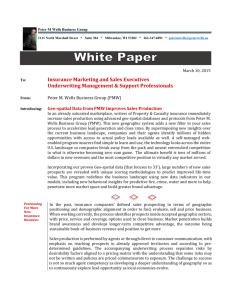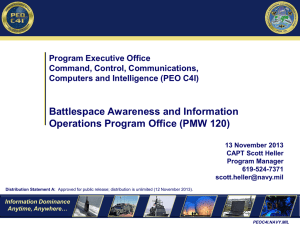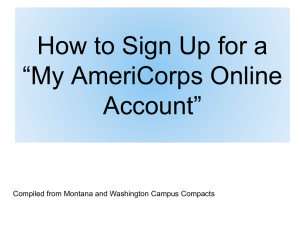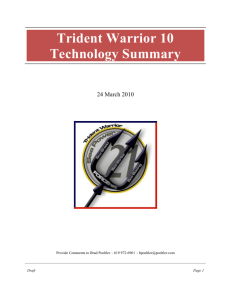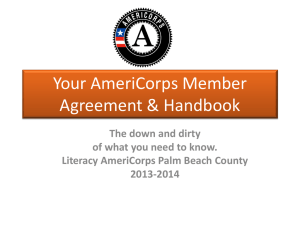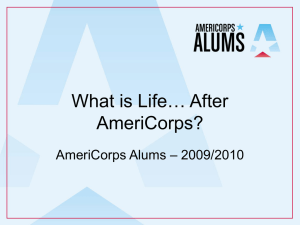CA Performance Measurement Worksheets Presentation
advertisement
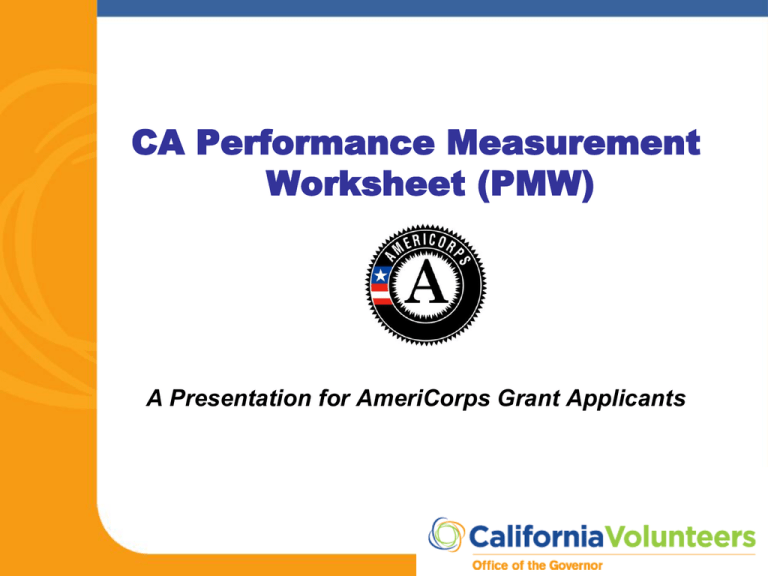
CA Performance Measurement Worksheet (PMW) A Presentation for AmeriCorps Grant Applicants Session Overview Review performance measurement concepts and definitions Review CA PMW components Review use of National Performance Measures Questions and answers Important Dates November 3, 2014 Notice of Intent to Apply Due by 5:00pm November 24, 2014 Applications Due by 5:00pm Week of December 22, 2014 Clarification Requests for Competitive Dec. 29, 2014 – Jan. 2, 2015 In-person Clarification Interview January 5, 2015 Clarification Response/Competitive Rewrite Due to CV January 16, 2015 Competitive Applications due in eGrants January 17-21, 2015 eGrants Application Review/Final Edits April 2015 CV Issues Clarification Request for Formula Waitlist June 2015 Funding Results Announced July – October 2015 Contracting Process and Program Launch What is performance measurement? ….systematic process for measuring program outputs and outcomes. Outputs • Amount of service provided (people served, products created, or programs developed) Outcomes • Changes or benefits that occur as the result of the intervention • Changes in individuals, organizations, communities, or the environment • Changes in attitudes/beliefs, knowledge/skills, behavior, or conditions Why Measure Performance? Accountability to funders and stakeholders • Tell your story, justify funding Recognizing progress; reflects change • Reliable information collected in a systematic way Program Improvement • Spot and correct problems • Strengthen the intervention • Determine technical assistance needs • Determine where to allocate resources Theory of Change/Logic Model Theory of Change The theory that the program’s specific intervention to address a community need will provide the intended outcomes Community Problem/Need Specific Intervention “cause” Intended Outcome “effect” Alignment within Theory of Change Strong alignment among the theory of change elements sets the stage for identifying quality performance measures Community Problem/Need Specific Intervention “cause” Intended Outcome “effect” Align Output and Outcome Alignment of Outputs and Outcomes: • Intervention produces output • Output leads to the outcome • Output and outcome measure the same intervention and beneficiaries Logic Model Logic Model A detailed visual representation of a program and its theory of change Communicates how a program works by depicting the intended relationships among program components Key PMW Requirements Each applicant will need to complete a set of CA Performance Measurement Worksheets (PMW): 1. 2. 3. A fully-aligned PMW for the primary needs and service activity. Common Strengthening Communities PMW Common Member Development PMW The Primary and Common Strengthening Communities PMWs combined must account for at least 80% of total member hours. Member development activities cannot exceed 20% of total member hours. Each additional secondary needs and service PMW must have an output and outcome. A separate PMW is required for any proposed allowable fundraising activities. PMW Components COMMUNITY’S DESIRE PROGRAM INPUTS PROGRAM INTERVENTION INTENDED RESULTS [1] Need [2] Result [3] Indicator [4] Amount of Service [5] Target Population & Activities [6] Measurement [7] Output & Outcome Targets 1. Community Need This is where your PM starts! Detailed information should be in your Narrative. On the PMW you should: Clearly identify the need you’ll address. Use data from reliable local sources. Just the highlights of relevant facts 2. Result What the community hopes to achieve. A statement in direct response to the community need. Two types: 1. Output: states amount of work or product created/delivered. 2. Outcome: states the change that will occur due to the service. 3. Indicator It is a specific item to gauge progress toward the Result: It identifies the information/data to collect to assess progress It operationalizes the Result Measurable in a program year Each Result needs an Indicator 4. Inputs/Amount of Service Think about the amount of effort needed to achieve the Result for the number you hope to serve. a. # Members: b. Hours per day: c. Days per week: d. Duration [weeks]: e. Total estimated hours for the activity: 5. Target Population Describe the “high need” group. Your narrative describes who/what needed AC services. Your activities should focus on those groups. a. High need target pop.: [HINT: Review Community Need narrative] b. # of direct high need beneficiaries: c. Describe how you will identify & select to assure you have high need beneficiaries. 5. Service Activities This is the intervention designed to address the Need & achieve the Result. PMs are all about what members do. Describe exactly what members will be doing to achieve the Result. This doesn’t need to be long, just descriptive. Service Activities Describe how you will achieve the result. Who or what is the member working with? (high need group, general group, individuals) What is being done? (manageable details!) How long is the service? (hour, 20 mins a day) How often is it done? (2x a week, M-W-F) Where is the service conducted? Service Activity Tips This is where you describe the service. This isn’t about “why”, it’s about “what” and “how” the activity is being done. Describe exactly what members do. “Tutoring” or “mentoring” mean what? This is not the place to “justify” service. Avoid repeating information in PMW 6. Measurement How will you measure progress? For each Indicator listed in #3 identify: Fill-in instrument name to collect data on fill-in data needed. 1.Instrument name [HINT: this is not the “method”] 2.Data to be collected [HINT: stated in Indicator] 3.Who will complete the instrument 4.How often it will be completed 6. Measurement Examples Fill-in instrument name to collect data on fill-in data needed. Examples: Client Progress Report to collect data on independent living level. Forest Dept. Assessment to collect data on number of saplings thriving. 1st Responders Training Sign-in Sheet to collect data on attendance. 7. Targets Targets are the quantifiable level of change desired to say service activity was successful. Targets should be your best estimate Be realistic--not too high & not too low Use previous data/research to estimate 7. Outcome Targets Outcome Targets need to include: 1. Who changed [high need group receiving XX amount of AC services] 2. Number who changed [percentage and raw number] 3. What changed [e.g., knowledge, skill, behavior, conditions] 4. Amount of change [e.g., percent, points, level, certification] Target Examples 220 of 400 (55%) elderly [targeted for a nursing home] receiving 30 hours of assistance, will remain “in their homes at least 4 months after service”. 60 of 100 (60%) members receiving 40 hours of training will pass 1st Responders certification as trainers. 300 of 500 (60%) saplings planted will be rated as “thriving” by the State Forest Dept. six months after planting 132 of 220 (60%) tutees [behind 2 grade levels], receiving 30 hours of tutoring, will increase reading skill by 1 grade level National Performance Measures Reflect the CNCS Strategic Plan and its programming priorities in the six stated focus areas Use of National Performance Measure is strongly encouraged but is not required. Included in 2015 CNCS National Performance Measures Instructions National Performance Measures 2015 CNCS National Performance Instructions include: Selection rules that specify required output/outcome pairings. Definitions for the intervention, target population, output and outcome How to calculate, measure, and collect data Technical Assistance Webinars RFA Guidance and Application Instructions Overview • Tuesday, October 28, 10:00 – 11:30 am PDT • Tuesday, October 28, 2:00 – 3:30 pm PDT AmeriCorps Program Logic Model • Wednesday, October 29, 2:00 – 3:30 pm PDT California Performance Measurement Worksheets (PMWs) • Thursday, October 30, 2:00 – 3:30 pm PDT AmeriCorps Application Components Q & A • Friday, October 31, 10:00 – 11:00 am PDT Questions? • Email any questions to Funding@CaliforniaVolunteers.ca.gov • FAQs will be posted weekly on Thursday mornings on CV’s website: www.californiavolunteers.org/ index.php/Grants/americorps/ Questions? THANK YOU!
